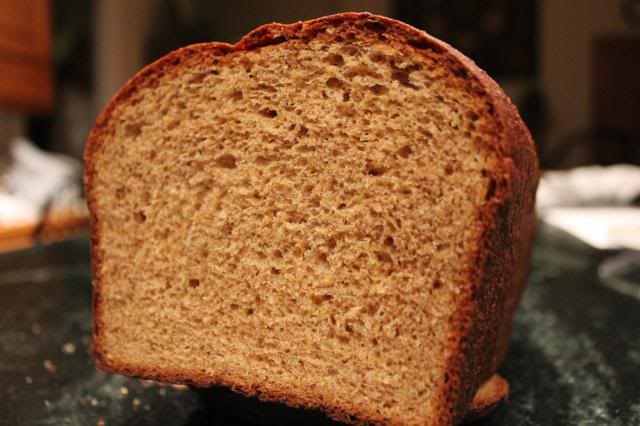The past two weeks have been rather more demanding than usual. We had gone to Colorado Springs to visit our youngest daughter's family for the Easter weekend. We were just a few minutes away from their house when my brother-in-law called to let us know that he had taken my mother-in-law to ER; her cancer that had been diagnosed a year and a half previously was causing new complications. We decided to cut our visit short and drive back to Kansas on Easter Sunday. The following morning, April 1, my wife flew to Traverse City, MI, to be with her mother. On Tuesday evening, April 2, my wife called to let me know that her mother had just died. While we knew it was coming, the circumstances made it a surprise; even for, or perhaps especially for, her physicians. I drove from KC to TC in a little more than 15 hours on Wednesday, April 3, to be with my wife and other members of her family. The funeral was Saturday, April 6.
We had planned to be in Michigan this week to help my brother and sister clear out the family farmhouse / garage / shop to make the place ready for renters, since my dad moved into an assisted living facility at the beginning of the year. Since I was already there, I stayed put to help with that process last week instead of making another trip home and back again. Meanwhile, my wife and her family were working to close up her mother's apartment. I flew back to KC on Saturday, leaving the car in Michigan for my wife. She intends to stay until her mother's interment. For those of you not acquainted with Michigan winters, sometimes the snow is too deep and the ground too frozen to permit the opening of a grave. This is one of those years.
Today has been a catching up kind of day: laundry, ironing, yard work, and so on. Thankfully, I needed bread. The therapeutic value of the making is every bit as great as the nutritional value of the eating.
Since my starter was in need of some therapy of its own, and since time didn't really allow for extended pre-ferments, I wanted a yeasted, straight dough style bread that would fit in with the other tasks of the day. That put me in mind of Bernard Clayton's The Complete Book of Breads, which has oodles of breads like that. And since I wanted something with plenty of whole grains, I thumbed through the multi-grain breads section of the book until I happened upon Sennecbec Hill bread. It's a bread I've made a number of times before, but probably not in the past 3-4 years. It contains rolled oats, corn meal, rye flour, and whole wheat flour; along with enough bread flour to tie everything together. It is fragrant with molasses, which also contributes to a rich brown crust and crumb. It makes a dandy sandwich bread or toast.
The recipe in the book, and at this site, is written with volumetric measures. Don't go bad-mouthing Mr. Clayton; at the time he wrote the book, American cooks and bakers weren't acquainted with the notion of using scales to weigh their ingredients. For those of you who are still on the fence about transitioning from volume measurements to weight measurements, here's a gentle nudge. All of the measurement items in the photo below were required for the recipe, as written. All of them had to be washed afterward. If the recipe was in weight measurements, you wouldn't have to use, or wash, any of them. That's right, scales save dishwashing! Even if you don't believe that using weight measurements will improve your baking experience (it will!), cutting down on the number of dishes to wash up should be a motivation to switch.
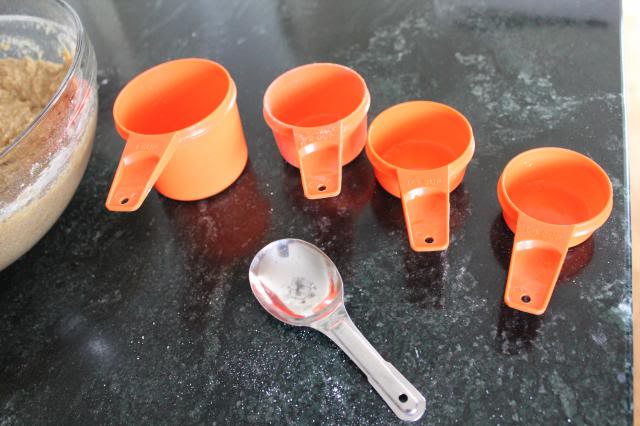
The process for this bread is dead simple: stir ingredients together as directed. Mix in bread flour until you have a "firm" (Clayton's word) dough. Knead. That's the tricky part with this bread. The molasses, oats, rye and whole wheat flours make for a sticky dough. There's a tendency to want to keep adding flour until the stickies go away. Don't. Do. That. Leave it somewhat sticky. Better to have gloopy hands while kneading (assuming that you hand knead) than a dry, crumbly brick of a loaf. I switched from a traditional push-turn-fold-push form of kneading to slap and folds as a means of continuing kneading when I gauged that more flour would be too much but the dough was still sticking to the countertop. The dough was a bit stiff for this method but wound up responding well. The aforesaid rolled oats, rye, and cornmeal mean that you want to have the gluten structure well established in the dough so that it can stand up to those unhelpful constituents.
Park the kneaded dough in a greased and covered bowl until it doubles in volume; sort of like this:
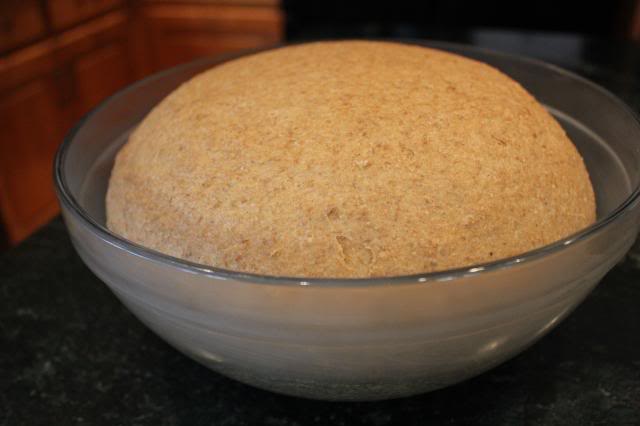
Then tip the dough out of the bowl onto the countertop and gently degas it. Shape into two loaves and place them in greased loaf pans. I weighed the loaves to make sure that they were equally sized. They each weighed 1 pound 13.5 ounces, which makes for a nice, full pan with 9x5 loaf pans. This is how they looked at this stage:
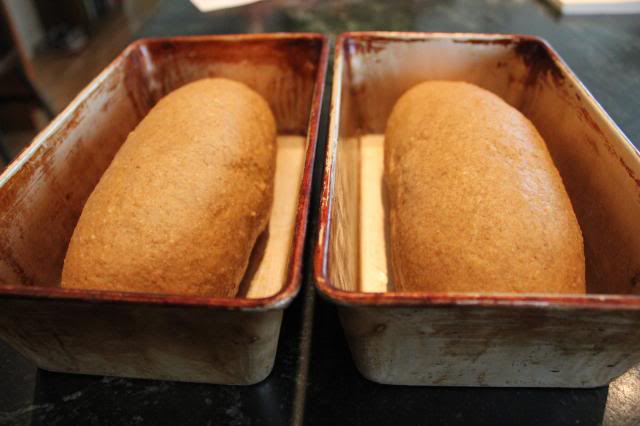
After covering them with plastic wrap, I was off to mow the yard. When I checked back in later, they were ready to bake:
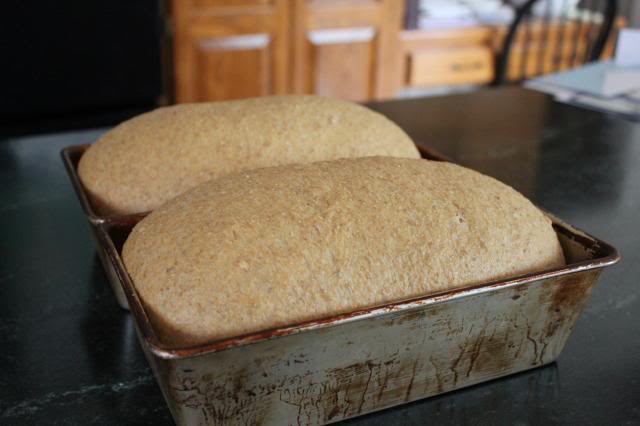
The critical reviewer will no doubt notice that those loaves are more than doubled in volume; probably closer to tripled. This is a sturdy dough and is able to stand up to that kind of expansion without collapsing. Nevertheless, I was very gentle while placing the pans in the preheated oven. The finished loaves did not exhibit any signifiicant oven spring; no surprise there. Neither did they show any sign of collapse, which means that they hadn't gone across the line to overproofing.
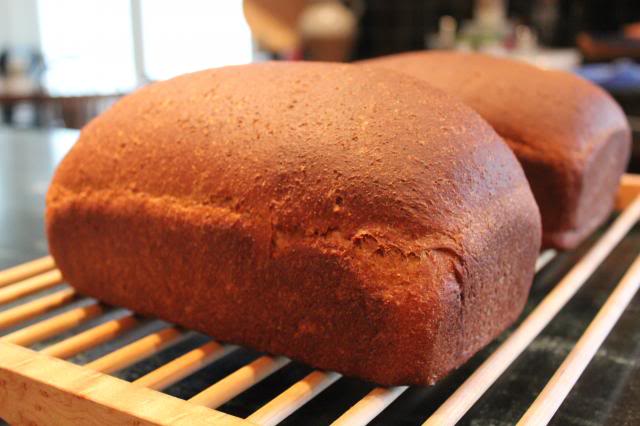
Pictures of the crumb will have to wait until tomorrow. The house smells wonderful and I anticipate tasty sandwiches for this week's lunches.
Paul
Update: Crumb pic. Fairly open, considering the rolled oats, corn meal, whole wheat, and rye flour. At the same time, a nice, even crumb that's great for sandwiches.
